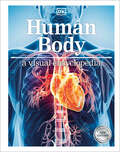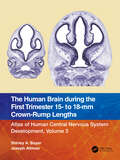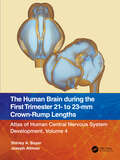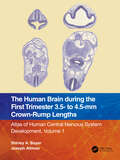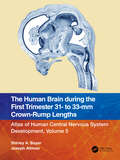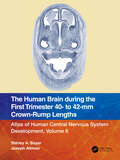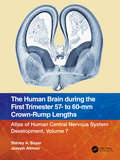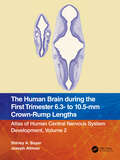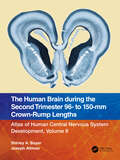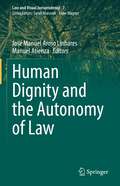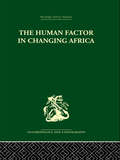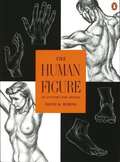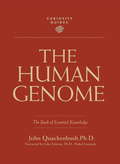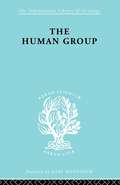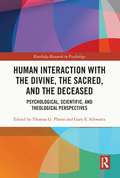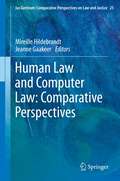- Table View
- List View
Human Body: A Visual Encyclopedia (DK Children's Visual Encyclopedias)
by DKLook inside yourself for the first time with the ultimate body book for children. From the hair on your head to the tips of your toes, this essential encyclopedia explores the super science going on under your skin.Did you know your amazing body consists of 100 trillion cells? Or that your blood vessels laid out end to end would wrap around planet Earth twice? And that you&’ll munch through 20 tonnes of food in your lifetime? Find out all this and much more on the epic journey of self-discovery, not forgetting your heads, shoulders, knees, and toes! During this introduction to anatomy, you&’ll stop off to see the different organs and systems designed to keep us going all day long. Check out the brilliant brain in action at the body&’s control center, the heart that never stops beating, the huge lungs filling with air to breathe, and the strong skeleton that keeps you from turning to jelly. Peel back the layers as you go deeper into the muscles, bones, cells, and finally, the DNA that makes you different from everyone else. This international best-seller has been fully updated to include the latest research on the human body. Stunning photographs, CGI artworks, and eye-catching graphics work together with accessible text, fun-filled facts, and quirky quizzes to ensure an exciting and educational experience that is second to none. This brilliant body book is the perfect study aid or homework help – and you&’ll never see yourself in the same way again!Supports the Common Core State Standards.
Human Body A Visual Encyclopedia
by DKUnderstand the human body from head to toe with this educational encyclopedia for children.Get to know how each part of the body works through amazing facts and colorful diagrams in this fully updated edition of the bestselling Human Body A Visual Encyclopedia.Did you know that you are made up of 100 trillion cells? Learn about blood vessels (capillaries, veins, and arteries) which, if they were laid out end to end, would wrap around the Earth twice! Find out what makes a balanced diet - after all, you will eat about 20 tons of food in your entire life!This human body book for kids offers: How the body works, looking at body parts and functions like bones and muscles, heart and blood, disease defenses, the life cycle, and much more.A human body encyclopedia that is suitable and informative for children aged 9+.A refreshed and updated edition, including a new design and the latest facts and stats on the human body.Make your way from the skin, muscles, organs, and bones, right down to your cells and DNA with this encyclopedia that combines clear descriptions of human biology with awesome photographs, diagrams, and CGI artworks. There are also fun quizzes, so you can assess your own personality and test your logical and reasoning skills.Explore the series!Globally, the Children’s Encyclopedia series has sold more than 4 million copies worldwide. Uncover the marvels of our world with Science, explore the deep blue with Ocean, explore our solar system and beyond with Space, and get to grips with world-famous sculptures with Art.
The Human Brain during the First Trimester 15- to 18-mm Crown-Rump Lengths: Atlas of Human Central Nervous System Development, Volume 3
by Shirley A. Bayer Joseph AltmanThis third of 15 short atlases reimagines the classic 5-volume Atlas of Human Central Nervous System Development. This volume presents serial sections from specimens between 15 mm and 18 mm with detailed annotations, together with 3D reconstructions. An introduction summarizes human CNS development by using high-resolution photos of methacrylate-embedded rat embryos at a similar stage of development as the human specimens in this volume. The accompanying Glossary gives definitions for all the terms used in this volume and all the others in the Atlas. Features Classic anatomical atlas Detailed labeling of structures in the developing brain offers updated terminology and the identification of unique developmental features, such as germinal matrices of specific neuronal populations and migratory streams of young neurons Appeals to neuroanatomists, developmental biologists, and clinical practitioners A valuable reference work on brain development that will be relevant for decades
The Human Brain during the First Trimester 21- to 23-mm Crown-Rump Lengths: Atlas of Human Central Nervous System Development, Volume 4
by Shirley A. Bayer Joseph AltmanThis fourth of 15 short atlases reimagines the classic 5-volume Atlas of Human Central Nervous System Development. This volume presents serial sections from specimens between 21 mm and 23 mm with detailed annotations, together with 3D reconstructions. An introduction summarizes human CNS development by using high-resolution photos of methacrylate-embedded rat embryos at a similar stage of development as the human specimens in this volume. The accompanying Glossary gives definitions for all the terms used in this volume and all the others in the Atlas. Key Features Classic anatomical atlases Detailed labeling of structures in the developing brain offers updated terminology and the identification of unique developmental features, such as, germinal matrices of specific neuronal populations and migratory streams of young neurons Appeals to neuroanatomists, developmental biologists, and clinical practitioners. A valuable reference work on brain development that will be relevant for decades
The Human Brain during the First Trimester 3.5- to 4.5-mm Crown-Rump Lengths: Atlas of Human Central Nervous System Development, Volume 1
by Shirley A. Bayer Joseph AltmanThis first of 15 short atlases reimagines the classic 5-volume Atlas of Human Central Nervous System Development. This volume presents serial sections from specimens between 3.5 mm and 4.5 mm with detailed annotations, together with 3D reconstructions. An introduction summarizes human CNS development by using high-resolution photos of methacrylate-embedded rat embryos at a similar stage of development as the human specimens in this volume. The accompanying Glossary gives definitions for all the terms used in this volume and all the others in the Atlas. Features Classic anatomical atlas Detailed labeling of structures in the developing brain offers updated terminology and the identification of unique developmental features, such as germinal matrices of specific neuronal populations and migratory streams of young neurons Appeals to neuroanatomists, developmental biologists, and clinical practitioners A valuable reference work on brain development that will be relevant for decades
The Human Brain during the First Trimester 31- to 33-mm Crown-Rump Lengths: Atlas of Human Central Nervous System Development, Volume 5
by Shirley A. Bayer Joseph AltmanThis fifth of 15 short atlases reimagines the classic 5-volume Atlas of Human Central Nervous System Development. This volume presents serial sections from specimens between 31 mm and 33 mm with detailed annotations, together with 3D reconstructions. An introduction summarizes human CNS development by using high-resolution photos of methacrylate-embedded rat embryos at a similar stage of development as the human specimens in this volume. The accompanying Glossary gives definitions for all the terms used in this volume and all the others in the Atlas. Features Classic anatomical atlases Detailed labeling of structures in the developing brain offers updated terminology and the identification of unique developmental features, such as, germinal matrices of specific neuronal populations and migratory streams of young neurons Appeals to neuroanatomists, developmental biologists, and clinical practioners A valuable reference work on brain development that will be relevant for decades
The Human Brain during the First Trimester 40- to 42-mm Crown-Rump Lengths: Atlas of Human Central Nervous System Development, Volume 6
by Shirley A. Bayer Joseph AltmanThis sixth of 15 short atlases reimagines the classic 5-volume Atlas of Human Central Nervous System Development. This volume presents serial sections from specimens between 40 mm and 42 mm with detailed annotations, together with 3D reconstructions. An introduction summarizes human CNS development by using high-resolution photos of methacrylate-embedded rat embryos at a similar stage of development as the human specimens in this volume. The accompanying Glossary gives definitions for all the terms used in this volume and all the others in the Atlas. Features Classic anatomical atlas Detailed labeling of structures in the developing brain offers updated terminology and the identification of unique developmental features, such as, germinal matrices of specific neuronal populations and migratory streams of young neurons Appeals to neuroanatomists, developmental biologists, and clinical practitioners A valuable reference work on brain development that will be relevant for decades
The Human Brain during the First Trimester 57- to 60-mm Crown-Rump Lengths: Atlas of Human Central Nervous System Development, Volume 7
by Shirley A. Bayer Joseph AltmanThe seventh of 15 short atlases reimagining the classic 5-volume Atlas of Human Central Nervous System Development. This volume presents serial sections from specimens between 57 mm and 60 mm with detailed annotations, together with 3D reconstructions. An introduction summarizes human CNS development by using high-resolution photos of methacrylate-embedded rat embryos at a similar stage of development as the human specimens in this volume. The accompanying Glossary gives definitions for all the terms used in this volume and all the others in the Atlas. Features • Classic anatomical atlas • Detailed labeling of structures in the developing brain offers updated terminology and the identification of unique developmental features, such as, germinal matrices of specific neuronal populations and migratory streams of young neurons • Appeals to neuroanatomists, developmental biologists, and clinical practitioners • A valuable reference work on brain development that will be relevant for decades
The Human Brain during the First Trimester 6.3- to 10.5-mm Crown-Rump Lengths: Atlas of Human Central Nervous System Development, Volume 2
by Shirley A. Bayer Joseph AltmanThis second of 15 short atlases reimagines the classic 5-volume Atlas of Human Central Nervous System Development. This volume presents serial sections from specimens between 6.3 mm and 10.5 mm with detailed annotations, together with 3D reconstructions. An introduction summarizes human CNS development by using high-resolution photos of methacrylate-embedded rat embryos at a similar stage of development as the human specimens in this volume. The accompanying Glossary gives definitions for all the terms used in this volume and all the others in the Atlas. Features Classic anatomical atlas Detailed labeling of structures in the developing brain offers updated terminology and the identification of unique developmental features, such as, germinal matrices of specific neuronal populations and migratory streams of young neurons Appeals to neuroanatomists, developmental biologists, and clinical practitioners A valuable reference work on brain development that will be relevant for decades
The Human Brain during the Second Trimester 160– to 170–mm Crown-Rump Lengths: Atlas of Human Central Nervous System Development, Volume 9
by Shirley A. Bayer Joseph AltmanThis ninth of 15 short atlases reimagines the classic 5-volume Atlas of Human Central Nervous System Development. This volume presents serial sections from specimens between 160 mm and 170 mm with detailed annotations. An introduction summarizes human CNS developmental highlights around 5 months of gestation. The Glossary (available separately) gives definitions for all the terms used in this voume and all the others in the Atlas. Features • Classic anatomical atlas • Detailed labeling of structures in the developing brain offers updated terminology and the identification of unique developmental features, such as germinal matrices of specific neuronal populations and migratory streams of young neurons • Appeals to neuroanatomists, developmental biologists, and clinical practitioners • A valuable reference work on brain development that will be relevant for decades
The Human Brain during the Second Trimester 190– to 210–mm Crown-Rump Lengths: Atlas of Human Central Nervous System Development, Volume 10
by Shirley A. Bayer Joseph AltmanThis tenth of 15 short atlases reimagines the classic 5-volume Atlas of Human Central Nervous System Development. This volume presents serial sections from specimens between 190 mm and 210 mm with detailed annotations. An introduction summarizes human CNS developmental highlights around 5 months of gestation. The Glossary (available separately) gives definitions for all the terms used in this volume and all the others in the Atlas. Features • Classic anatomical atlas • Detailed labeling of structures in the developing brain offers updated terminology and the identification of unique developmental features, such as germinal matrices of specific neuronal populations and migratory streams of young neurons • Appeals to neuroanatomists, developmental biologists, and clinical practitioners • A valuable reference work on brain development that will be relevant for decades
The Human Brain during the Second Trimester 96– to 150–mm Crown-Rump Lengths: Atlas of Human Central Nervous System Development, Volume 8
by Shirley A. Bayer Joseph AltmanThis eighth of 15 short atlases reimagines the classic 5-volume Atlas of Human Central Nervous System Development. This volume presents serial sections from specimens between 96 mm and 150 mm with detailed annotations. An introduction summarizes human CNS developmental highlights between 3.5 and 4.5 months of gestation. The accompanying Glossary (available free online) gives definitions for all the labels used in this volume and all the others in the Atlas. Key Features • Classic anatomical atlas • Detailed labeling of structures in the developing brain offers updated terminology and the identification of unique developmental features such as germinal matrices of specific neuronal populations and migratory streams of young neurons • Appeals to neuroanatomists, developmental biologists, and clinical practitioners • A valuable reference work on brain development that will be relevant for decades
The Human Brain during the Third Trimester 225– to 235–mm Crown-Rump Lengths: Atlas of Central Nervous System Development, Volume 11
by Shirley A. Bayer Joseph AltmanThis eleventh of 15 short atlases reimagines the classic 5-volume Atlas of Human Central Nervous System Development. This volume presents serial sections from specimens between 225 mm and 235 mm with detailed annotations. An introduction summarizes human CNS developmental highlights around 6.5 months of gestation. The Glossary (available separately) gives definitions for all the terms used in this volume and all the others in the Atlas. Key Features • Classic anatomical atlases • Detailed labeling of structures in the developing brain offers updated terminology and the identification of unique developmental features, such as germinal matrices of specific neuronal populations and migratory streams of young neurons • Appeals to neuroanatomists, developmental biologists, and clinical practitioners • A valuable reference work on brain development that will be relevant for decades
The Human Brain during the Third Trimester 260– to 270–mm Crown-Rump Lengths: Atlas of Central Nervous System Development, Volume 12
by Shirley A. Bayer Joseph AltmanThis twelfth of 15 short atlases reimagines the classic 5-volume Atlas of Human Central Nervous System Development. This volume presents serial sections from specimens between 260 mm and 270 mm with detailed annotations. An introduction summarizes human CNS developmental highlights around 6.5 months of gestation. The Glossary (available separately) gives definitions for all the terms used in this volume and all the others in the Atlas. Key Features • Classic anatomical atlases • Detailed labeling of structures in the developing brain offers updated terminology and the identification of unique developmental features, such as germinal matrices of specific neuronal populations and migratory streams of young neurons • Appeals to neuroanatomists, developmental biologists, and clinical practitioners • A valuable reference work on brain development that will be relevant for decades
The Human Brain during the Third Trimester 310– to 350–mm Crown-Rump Lengths: Atlas of Central Nervous System Development, Volume 13
by Shirley A. Bayer Joseph AltmanThis thirteenth of 15 short atlases reimagines the classic 5 volume Atlas of Human Central Nervous System Development. This volume presents serial sections from specimens between 310 mm and 350 mm with detailed annotations. An introduction summarizes human CNS developmental highlights around 9 months of gestation. The Glossary (available separately) gives definitions for all the terms used in this volume and all the others in the Atlas. Key Features • Classic anatomical atlases • Detailed labeling of structures in the developing brain offers updated terminology and the identification of unique developmental features, such as germinal matrices of specific neuronal populations and migratory streams of young neurons • Appeals to neuroanatomists, developmental biologists, and clinical practitioners • A valuable reference work on brain development that will be relevant for decades
Human Dignity and the Autonomy of Law (Law and Visual Jurisprudence #7)
by José Manuel Aroso Linhares Manuel AtienzaThis book intertwines two major themes in contemporary legal theory – the concepts of human dignity and the problem of the autonomy and limits of the law – while also addressing two other key aspects – the first one concerned with human rights practices and foundations (in their direct connections with the issue of dignity), the second one considering the role that the law’s aspirations attribute to the experience of an autonomous subject-person (and the demands that identify his/her position in the dialectical counterpoint with the rethinking of a community). The diversity of perspectives that each of these themes allows is explored in various contexts and with unmistakable implications concerning juridical validity, rule of law practices, pluralism, political and practical-cultural challenges, and divisive “bio-ethical” issues. This means considering the separation or separability theses between law and morality and the juridically relevant experience of person(hood) as a dialectic between autonomy and responsibility, the orthodox and heterodox images of comparable concreteness and incomparable singularity, the challenges of external points of view and interdisciplinary approaches.
Human-Environment Relations
by Pauline Phemister Emily BradyThis fresh and innovative approach to human-environmental relations will revolutionise our understanding of the boundaries between ourselves and the environment we inhabit. The anthology is predicated on the notion that values shift back and forth between humans and the world around them in an ethical communicative zone called 'value-space'. The contributors examine the transformative interplay between external environments and human values, and identify concrete ways in which these norms, residing in and derived from self and society, are projected onto the environment.
Human Evolution
by Graeme FinlayControversy over human evolution remains widespread. However, the human genome project and genetic sequencing of many other species have provided myriad precise and unambiguous genetic markers that establish our evolutionary relationships with other mammals. Human Evolution: Genes, Genealogies and Phylogenies identifies and explains these identifiable, rare and complex markers including endogenous retroviruses, genome-modifying transposable elements, gene-disabling mutations, segmental duplications and gene-enabling mutations. The new genetic tools also provide fascinating insights into when and how many features of human biology arose: from aspects of placental structure, vitamin C dependence and trichromatic vision, to tendencies to gout, cardiovascular disease and cancer. Bringing together a decade's worth of research and tying it together to provide an overwhelming argument for the mammalian ancestry of the human species, the book will be of interest to professional scientists and students in both the biological and biomedical sciences.
The Human Factor in Changing Africa
by Melville J. HerskovitsFocussing on the problems of change and resistance to change that mark the African sub-continent, this book examines Africa's place in the world from earliest times. It considers the nature of its peoples in their prehistoric development, the ways in which their cultures were oriented, and the ways in which these cultures guided their reactions to European ideas. It also assesses the human responses to industrial, technological and economic changes and the re-discovery by the Africans of African culture. Originally published in 1962.
The Human Figure: An Anatomy For Artists
by David K. RubinsA brief yet in-depth presentation of the human anatomy.
The Human Genome: The Book of Essential Knowledge
by John QuackenbushThe DNA sequence that comprises the human genome--the genetic blueprint found in each of our cells--is undoubtedly the greatest code ever to be broken. Completed at the dawn of a new millennium, the feat electrified both the scientific community and the general public with its tantalizing promise of new and better treatments for countless diseases, including Alzheimer's, cancer, diabetes, and Parkinson's. Yet what is arguably the most important discovery of our time has also opened a Pandora's box of questions about who we are as humans and how the unique information stored in our genomes can and might be used, making it all the more important for everyone to understand the new science of genomics. In the CURIOSITY GUIDE TO THE HUMAN GENOME, Dr. John Quackenbush, a renowned scientist and professor, conducts a fascinating tour of the history and science behind the Human Genome Project and the technologies that are revolutionizing the practice of medicine today. With a clear and engaging narrative style, he demystifies the fundamental principles of genetics and molecular biology, including the astounding ways in which genes function, alone or together with other genes and the environment, to either sustain life or trigger disease. In addition, Dr. Quackenbush goes beyond medicine to examine how DNA-sequencing technology is changing how we think of ourselves as a species by providing new insights about our earliest ancestors and reconfirming our inextricable link to all life on earth. Finally, he explores the legal and ethical questions surrounding such controversial topics as stem cell research, prenatal testing, forensics, and cloning, making this volume of the Curiosity Guides series an indispensable resource for navigating our brave new genomic world.
The Human Group (International Library of Sociology)
by George C. HomansPublished in 1998, The Human Group is a valuable contribution to the field of Sociology and Social Policy.
Human Interaction with the Divine, the Sacred, and the Deceased: Psychological, Scientific, and Theological Perspectives (Routledge Research in Psychology)
by Gary E. Schwartz Thomas G. PlanteHuman Interaction with the Divine, the Sacred, and the Deceased brings together cutting-edge empirical and theoretical contributions from scholars in fields including psychology, theology, ethics, neuroscience, medicine, and philosophy, to examine how and why humans engage in, or even seek spiritual experiences and connection with the immaterial world. In this richly interdisciplinary volume, Plante and Schwartz recognize human interaction with the divine and departed as a cross-cultural and historical universal that continues to concern diverse disciplines. Accounting for variances in belief and human perception and use, the book is divided into four major sections: personal experience; theological consideration; medical, technological, and scientific considerations; and psychological considerations with chapters addressing phenomena including prayer, reincarnation, sensed presence, and divine revelations. Featuring scholars specializing in theology, psychology, medicine, neuroscience, and ethics, this book provides a thoughtful, compelling, evidence-based, and contemporary approach to gain a grounded perspective on current understandings of human interaction with the divine, the sacred, and the deceased. Of interest to believers, questioners, and unbelievers alike, this volume will be key reading for researchers, scholars, and academics engaged in the fields of religion and psychology, social psychology, behavioral neuroscience, and health psychology. Readers with a broader interest in spiritualism, religious and non-religious movements will also find the text of interest.
Human Law and Computer Law: Comparative Perspectives
by Jeanne Gaakeer Mireille HildebrandtThe focus of this book is on the epistemological and hermeneutic implications of data science and artificial intelligence for democracy and the Rule of Law. How do the normative effects of automated decision systems or the interventions of robotic fellow 'beings' compare to the legal effect of written and unwritten law? To investigate these questions the book brings together two disciplinary perspectives rarely combined within the framework of one volume. One starts from the perspective of 'code and law' and the other develops from the domain of 'law and literature'. Integrating original analyses of relevant novels or films, the authors discuss how computational technologies challenge traditional forms of legal thought and affect the regulation of human behavior. Thus, pertinent questions are raised about the theoretical assumptions underlying both scientific and legal practice.
